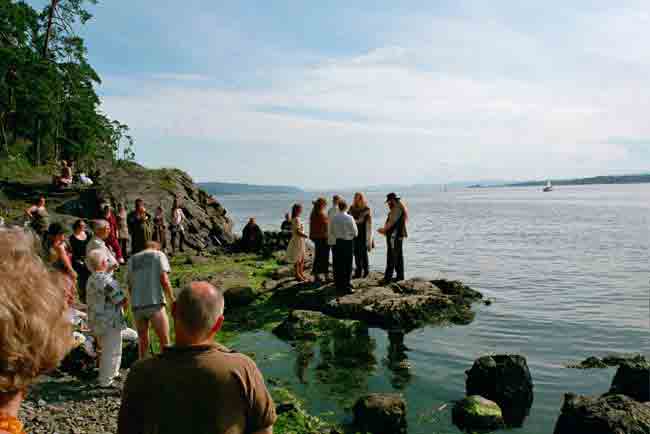
Winter is here. On Saturday pagans in Iceland celebrated the first day of winter with the traditional ceremony of Haustblót (“autumn sacrifice”). IR Web Editor Eygló S. Arnarsdóttir observed.
Steam rose from the dinner on the table, the autumn sacrifice. The guests waited patiently for their horse meat, blood pudding and liver sausage to be blessed before they could start feasting upon it.
Most of them were modernly dressed, but others looked as if they had jumped right out of the Viking era. The traditionally dressed men wore plain shirts or sweaters nit with Icelandic wool. Some sported long hair and a beard.
The women wore long white dresses with colorful aprons on top, decorated with jewelry. The most popular necklace motive with both sexes was the hammer of Thor in gold or made out of reindeer horn.
The high chieftain and two of his assistants stood behind the altar. The priest held a horn in his hand decorated with runes. He blessed the gods, the assembly and the food, drank some of the beer in the horn and poured some over the altar.
A stuffed raven perched on the bar. It overlooked a circular altar filled with candles. The whole room was illuminated by candles, giving it a mythical air.
“Heill Ódni,” the head priest said (“Odin – the leader of gods – is holy”). The guests repeated. “Heill Freyju,” he continued (“Freyja – the goddess of love – is holy”). The room echoed. “May the feast begin,” the priest announced.
Haustblót is one of five yearly celebrations. Pagans celebrate the first day of winter and the first day of summer, winter and summer solstice and Thorrablót, a midwinter feast.
The Pagan Society (Ásatrúarfélagið) was founded in the early 1970s, but the religion, based on Norse mythology, goes back hundreds of years. Ásatrú is the religion the Vikings practiced.
“Don’t call it a religion, it’s a lifestyle,” says society member Anna Bergsteinsdóttir. “It is about coming together and having a good time.” Bergsteinsdóttir used to be Christian but converted to Ásatrú four years ago.
Member Jóhannes Levy believes Icelanders are pagans at heart, although they might be Christian on the outside. Christianity became state religion in year 1000, but pagan values have been kept alive in Iceland to this day.
High Priest Hilmar Örn Hilmarsson explains that being a pagan means taking responsibility and being tolerant towards others. They welcome every new member, and the numbers are increasing, but do not want to force Ásatrú upon anyone.
Getting married the pagan way is becoming increasingly popular, among Icelanders and tourists alike. It is not required that the couple is pagan, they can belong to any religious group.
Soon pagans in Iceland will have a temple of their own for their feasts and holy ceremonies. It will be built in Öskjuhlíd in Reykjavík, near the restaurant Perlan.
.






No comments:
Post a Comment